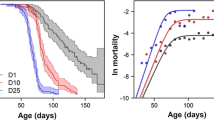Summary
The reproductive phenology of the freshwater copepod Diaptomus sanguineus differs markedly between populations residing in two Rhode Island ponds. In a permanent pond the population switches abruptly from making subitaneous (immediately hatching) eggs to diapausing eggs at the end of March each year. In contrast, a temporary pond population switches egg types in May, returns to production of subitaneous eggs in June, and concludes the reproductive season by making diapausing eggs in July. An ESS model suggests that the pattern of diapause expected of a copepod population is a function of annual variation in the onset of harsh conditions (catastrophe date). When variation is relatively low, the superior strategy is for diapause to begin a constant period before the mean catastrophe date. When variation is high, females should make first subitaneous eggs and then diapausing eggs irrespective of the expected catastrophe date. With discrete generations, such a population would alternate between egg types. In the permanent pond, variation of catastrophe date the spring onset of planktivory by sunfish is low, whereas in the temporary pond variation of the catastrophe (pond drying) is high. The model predicts well the phenology of the two copepod populations.
In the research reported here, we tested the hypothesis that copepods from the permanent pond, which switch to diapause at the same time every year, are cued by the environment to begin diapause (i.e. by photoperiod, temperature, or both), whereas those from the temporary pond make both egg types regardless of environmental conditions. In opposition to our hypothesis, experimental results indicate that diapause in both populations is cued by the environment. The distinct reproductive phenologies documented in the two populations apparently result from the copepods responding to different environmental cues, rather than one being responsive to the environment while the other is not.
Similar content being viewed by others
References
Angevine MW, Chabot BF (1979) Seed germination syndromes in higher plants. In: Solbrig OT, Jain S, Johnson GB, Raven PH (eds) Topics in plant population biology. Columbia Univ, New York
Beck SD (1980) Insect photoperiodism. 2nd ed Academic Press, New York
Champeau A (1970) Etude de la vie latent chez les Calanoides (Copepodes) characteristiques des eaux temporaires de Basse-Provence. Ann Fac Sci Marseille 44:155–189
Hairston NG Jr (1986) Diapause as a predator avoidance adaptation. In: Kerfoot WC, Sih A (eds) Predation: direct and indirect impacts on aquatic communites. Univ Press New England, Hanover (in press)
Hairston NG Jr, Munns WR Jr (1984) The timing of copepod diapause as an evolutionarily stable strategy. Am Nat 123:733–751
Hairston NG Jr, Olds EJ (1984) Population differences in the timing of diapause: adaptation in a spatially heterogeneous environment. Oecologia (Berlin) 61:42–48
Hairston NG Jr, Olds EJ (1986) Partial photoperiodic control of diapause in three populations of the freshwater copepod Diaptomus sanguineus. Biol Bull 171:135–142
Hairston NG Jr, Walton WE (1986) Rapid evolution of a life history trait. Proc Natl Acad Sci USA 83:4831–4833
Hairston NG Jr, Walton WE, Li KT (1983) The causes and consequences of sex-specific mortality in a freshwater copepod. Limnol Oceanogr 28:935–947
Hairston NG Jr, Olds EJ, Munns WR Jr (1985) Bet-hedging and environmentally cued diapause strategies of diaptomid copepods. Int Ver Theor Angew Limnol Verh 22:3170–3177
Harper JL (1977) Population biology of plants. Academic Press, New York
Hoy MA (1977) Rapid response to selection for a nondiapausing gypsy moth. Science 196:1462–1463
Istock CA (1981) Natural selection and life history variation: theory plus lessons from a mosquito. In: Denno RF, Dingle H (eds) Insect life history patterns: habitat and geographic variation. Springer, New York
Levin SA, Cohen D, Hastings A (1984) Dispersal strategies in patchy environments. Theor Pop Biol 26:165–191
Lumme J (1982) Phenology and photoeriodic diapause in northern populations of Drosophila. In: Dingle H (ed) Evolution of insect migration and diapause. Springer, New York
Marcus NH (1980) Photoperiodic control of diapause in the marine calanoid copepod Labidocera aestiva. Biol Bull 159:311–318
Marcus NH (1982) Photoperiodic and temperature regulation of diapause in Labidocera aestiva (Copepoda: Calanoida). Biol Bull 162:45–52
Marcus NH (1984) Variation in the diapause responses of Labidocera aestiva (Copepoda: Calanoida) from different latitudes and its importance in the evolutionary process. Biol Bull 166:127–139
Masaki S (1967) Geographic variation and climatic adaptation in a field cricket (Orthoptera: Gryllidae). Evolution 21:725–741
Ravera O, Tonolli V (1956) Body size and number of eggs in diaptomid copepods as related to water renewal in mountain lakes. Limnol Oceanogr 1:118–122
Roen U (1957) Contributions to the biology of some Danish free living copepods. Biol Skr Dan Vid Selsk 9, no 2
Showers WB, Chiang HC, Keaster AJ, Hill RE, Reed GL, Sparks AN, Musick GJ (1975) Ecotypes of the European corn borer in North America. Environ Entomol 4:753–760
Tauber MJ, Tauber CA (1970) Photoperiodic induction and termination of diapause in an insect: response to changing day lengths. Science 167:170
Tauber MJ, Tauber CA, Masaki S (1984) Adaptations to hazardous seasonal conditions: dormancy, migration, and polyphenism. In: Huffaker CB, Rabb RL (eds) Ecological entomology. Wiley, New York
Tauber MJ, Tauber CA, Masaki S (1986) Seasonal adaptations of insects. Oxford Univ, New York
Taylor F (1980) Optimal switching to diapause in relation to the onset of winter. Theor Pop Biol 18:125–133
Walton WE (1985) Factors regulating the reproductive phenology of Onychodiaptomus birgei (Copepoda: Calanoida). Limnol Oceanogr 30:167–179
Author information
Authors and Affiliations
Rights and permissions
About this article
Cite this article
Hairston, N.G., Olds, E.J. Population differences in the timing of diapause: a test of hypotheses. Oecologia 71, 339–344 (1987). https://doi.org/10.1007/BF00378705
Received:
Issue Date:
DOI: https://doi.org/10.1007/BF00378705




